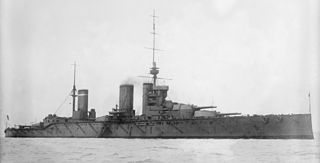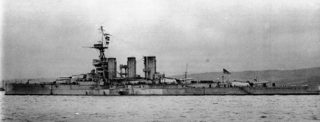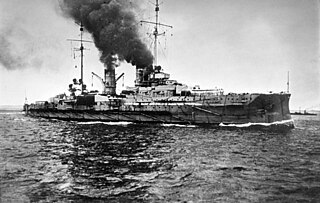
The battlecruiser was a type of capital ship of the first half of the 20th century. These were similar in displacement, armament and cost to battleships, but differed in form and balance of attributes. Battlecruisers typically had thinner armour and a somewhat lighter main gun battery than contemporary battleships, installed on a longer hull with much higher engine power in order to attain greater speeds. The first battlecruisers were designed in the United Kingdom, as a development of the armoured cruiser, at the same time as the dreadnought succeeded the pre-dreadnought battleship. The goal of the design was to outrun any ship with similar armament, and chase down any ship with lesser armament; they were intended to hunt down slower, older armoured cruisers and destroy them with heavy gunfire while avoiding combat with the more powerful but slower battleships. However, as more and more battlecruisers were built, they were increasingly used alongside the better-protected battleships.

HMS Queen Mary was the last battlecruiser built by the Royal Navy before the First World War. The sole member of her class, Queen Mary shared many features with the Lion-class battlecruisers, including her eight 13.5-inch (343 mm) guns. She was completed in 1913 and participated in the Battle of Heligoland Bight as part of the Grand Fleet in 1914. Like most of the modern British battlecruisers, the ship never left the North Sea during the war. As part of the 1st Battlecruiser Squadron, Queen Mary attempted to intercept a German force that bombarded the North Sea coast of England in December 1914, but was unsuccessful. The ship was refitting in early 1915 and missed the Battle of Dogger Bank in January, but participated in the largest fleet action of the war, the Battle of Jutland in mid-1916. She was hit twice by the German battlecruiser Derfflinger during the early part of the battle and her magazines exploded shortly afterwards, sinking the ship.

HMS Inflexible was one of three Invincible-class battlecruisers built for the Royal Navy before World War I and had an active career during the war. She tried to hunt down the German battlecruiser SMS Goeben and the light cruiser SMS Breslau in the Mediterranean Sea when war broke out and she and her sister ship Invincible sank the German armoured cruisers SMS Scharnhorst and SMS Gneisenau during the Battle of the Falkland Islands. Inflexible bombarded Turkish forts in the Dardanelles in 1915, but was damaged by return fire and struck a mine while maneuvering. She had to be beached to prevent her from sinking, but she was patched up and sent to Malta, and then Gibraltar for more permanent repairs. Transferred to the Grand Fleet afterwards, she damaged the German battlecruiser Lützow during the Battle of Jutland in 1916 and watched Invincible explode. She was deemed obsolete after the war and was sold for scrap in 1921.

The Lion class were a pair of battlecruisers built for the Royal Navy before World War I. Nicknamed the "Splendid Cats", the ships were a significant improvement over their predecessors of the Indefatigable class in speed, armament and armour. These improvements were in response to the German battlecruisers of the Moltke class, which were in turn larger and more powerful than the first British battlecruisers of the Invincible class.

HMS New Zealand was one of three Indefatigable-class battlecruisers. Launched in 1911, the ship was funded by the government of New Zealand as a gift to Britain, and she was commissioned into the Royal Navy in 1912. She had been intended for the China Station, but was released by the New Zealand government at the request of the Admiralty for service in British waters.

HMS Invincible was the lead ship of her class of three battlecruisers built for the Royal Navy during the first decade of the twentieth century and the first battlecruiser to be built by any country in the world. During the First World War, she participated in the Battle of Heligoland Bight in a minor role, as she was the oldest and slowest of the British battlecruisers present. During the Battle of the Falkland Islands, Invincible and her sister ship Inflexible sank the armoured cruisers Scharnhorst and Gneisenau almost without loss to themselves, despite numerous hits by the German ships.

The three Invincible-class battlecruisers were built for the Royal Navy and entered service in 1908 as the world's first battlecruisers. They were the brainchild of Admiral Sir John ("Jacky") Fisher, the man who had sponsored the construction of the world's first "all-big-gun" warship, HMS Dreadnought. He visualised a new breed of warship, somewhere between the armoured cruiser and battleship; it would have the armament of the latter, but the high speed of the former. This combination would allow it to chase down most ships, while allowing it to run from more powerful designs.

HMS Princess Royal was the second of two Lion-class battlecruisers built for the Royal Navy before the First World War. Designed in response to the Moltke-class battlecruisers of the Imperial German Navy, the ships significantly improved on the speed, armament, and armour of the preceding Indefatigable class. The ship was named after Louise, The Princess Royal, a title occasionally granted to the Monarch's eldest daughter.

HMS Lion was a battlecruiser built for the Royal Navy in the 1910s. She was the lead ship of her class, which were nicknamed the "Splendid Cats". They were significant improvements over their predecessors of the Indefatigable class in terms of speed, armament and armour. This was in response to the first German battlecruisers, the Moltke class, which were very much larger and more powerful than the first British battlecruisers, the Invincible class.

HMS Indefatigable was the lead ship of her class of three battlecruisers built for the Royal Navy during the first decade of the 20th Century. When the First World War began, Indefatigable was serving with the 2nd Battlecruiser Squadron (BCS) in the Mediterranean, where she unsuccessfully pursued the battlecruiser Goeben and the light cruiser Breslau of the German Imperial Navy as they fled toward the Ottoman Empire. The ship bombarded Ottoman fortifications defending the Dardanelles on 3 November 1914, then, following a refit in Malta, returned to the United Kingdom in February where she rejoined the 2nd BCS.

The Indefatigable class were the second class built of British battlecruisers which served in the Royal Navy and the Royal Australian Navy during World War I. The design represented a modest reworking of the preceding Invincible class, featuring increased endurance and an improved cross-deck arc of fire for their midships wing turrets achieved by a lengthening of the hull. Like its predecessor, the design resembled the contemporary dreadnought of the Royal Navy, but sacrificed armour protection and one turret from the main battery for a 4-knot speed advantage.

HMS Defence was a Minotaur-class armoured cruiser built for the Royal Navy in the first decade of the 20th century, the last armoured cruiser built for the Royal Navy. She was stationed in the Mediterranean when the First World War began and participated in the pursuit of the German battlecruiser SMS Goeben and light cruiser SMS Breslau. The ship was transferred to the Grand Fleet in January 1915 and remained there for the rest of her career.

HMS Tiger was a battlecruiser built for the Royal Navy during the 1910s. The ship was the most heavily armoured British battlecruiser at the start of the First World War in 1914, but was not yet ready for service. The ship was assigned to the 1st Battlecruiser Squadron for the duration of the war and participated in the Battle of Dogger Bank in early 1915, though she was still shaking down and did not perform well. Tiger next participated in the Battle of Jutland in 1916, where she was only lightly damaged despite suffering many hits by German shells. Apart from providing distant cover during the Second Battle of Heligoland Bight in 1917, she spent the rest of the war on uneventful patrols in the North Sea.

SMS Derfflinger was a battlecruiser of the German Kaiserliche Marine built in the early 1910s during the Anglo-German naval arms race. She was the lead ship of her class of three ships; her sister ships were Lützow and Hindenburg. The Derfflinger-class battlecruisers were larger and featured significant improvements over the previous German battlecruisers, carrying larger guns in a more efficient superfiring arrangement. Derfflinger was armed with a main battery of eight 30.5 cm (12 in) guns, compared to the 28 cm (11 in) guns of earlier battlecruisers. She had a top speed of 26.5 knots and carried heavy protection, including a 30-centimeter (11.8 in) thick armored belt.

SMS Blücher was the last armored cruiser built by the German Empire. She was designed to match what German intelligence incorrectly believed to be the specifications of the British Invincible-class battlecruisers. Blücher was larger than preceding armored cruisers and carried more heavy guns, but was unable to match the size and armament of the battlecruisers which replaced armored cruisers in the British Royal Navy and German Imperial Navy. The ship was named after the Prussian Field Marshal Gebhard von Blücher, the commander of Prussian forces at the Battle of Waterloo in 1815.

SMS Von der Tann was the first battlecruiser built for the German Kaiserliche Marine, as well as Germany's first major turbine-powered warship. At the time of her construction, Von der Tann was the fastest dreadnought-type warship afloat, capable of reaching speeds in excess of 27 knots. She was designed in response to the British Invincible class. While the German design had slightly lighter guns—28 cm (11 in), compared to the 30.5 cm (12 in) Mark X mounted on the British ships—Von der Tann was faster and significantly better-armored. She set the precedent of German battlecruisers carrying much heavier armor than their British equivalents, albeit at the cost of smaller guns.

The pursuit of Goeben and Breslau was a naval action that occurred in the Mediterranean Sea at the outbreak of the First World War when elements of the British Mediterranean Fleet attempted to intercept the German Mittelmeerdivision consisting of the battlecruiser SMS Goeben and the light cruiser SMS Breslau. The German ships evaded the British fleet and passed through the Dardanelles to reach Constantinople, where they were eventually handed over to the Ottoman Empire. Renamed Yavuz Sultan Selim and Midilli, the former Goeben and Breslau were ordered by their German commander to attack Russian positions, in doing so bringing the Ottoman Empire into the war on the side of the Central Powers.
The Admiral-class battlecruisers were to have been a class of four British Royal Navy battlecruisers built near the end of World War I. Their design began as an improved version of the Queen Elizabeth-class battleships, but it was recast as a battlecruiser after Admiral John Jellicoe, commander of the Grand Fleet, pointed out that there was no real need for more battleships, but that a number of German battlecruisers had been laid down that were superior to the bulk of the Grand Fleet's battlecruisers and the design was revised to counter these. The class was to have consisted of HMS Hood, Anson, Howe, and Rodney — all names of famous admirals — but the other three ships were suspended as the material and labour required to complete them was needed for higher-priority merchantmen and escort vessels. Their designs were updated to incorporate the lessons from the Battle of Jutland, but the Admiralty eventually decided that it was better to begin again with a clean-slate design so they were cancelled in 1919. No more battlecruisers would be built due to the arms limitations agreements of the interbellum.

HMS Gloucester was a Town-class light cruiser built for the Royal Navy in the first decade of the 20th century. The ship was initially assigned to the Home Fleet upon commissioning in 1910 and was transferred to the Mediterranean Fleet in 1913. She was involved in the hunt for the German ships Goeben and Breslau after World War I began in August 1914. Gloucester was detailed several times during the war to search for German commerce raiders, but her only success was the capture of one supply ship in early 1915. She played a minor role in the Battle of Jutland in mid-1916 and then spent most of the rest of the war in the Adriatic Sea. The ship was placed in reserve in 1919 and was sold for scrap in 1921.




















